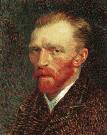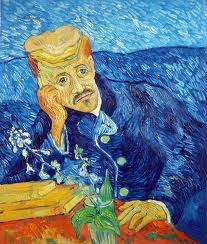Vincent van Gogh 1853 – 1890
November 01, 2008
 Vincent Willem van
Gogh 1853 – 1890 was a
Dutch Post Impressionist artist.
Vincent Willem van
Gogh 1853 – 1890 was a
Dutch Post Impressionist artist.
Vincent van Gogh was a friend of Emile Bernard, Eugene Boch, Paul Gauguin, Henri de Toulouse Lautrec, Dodge MacKnight, Camille Pissarro, Pierre Auguste Renoir, Georges Seurat, Paul Signac, and many others.
However, despite his wide circle of friends and family, Vincent van Gogh [was a depressive, with a history of gonorrhoea and syphilis. In 1888, he cut off his ear, and he spent a year in a mental institution in 1889
- 1890 before he met](http://en.wikipedia.org/wiki/Vincent_van_Gogh) homeopath Paul Ferdinand Gachet, whose treatment and friendship led to the most productive time in Vincent’s ‘cold and lonely’ life.
During his time under Paul Ferdinand Gachet’s care, Vincent painted 70 paintings in 70 days.
It was Camile Pissarro who recommended that Vincent van Gogh see his homeopath Paul Ferdinand Gachet.
Vincent van Gogh painted Paul Ferdinand
Gachet’s
portrait 
Paul Ferdinand Gachet was the homeopathic practitoner of Paul Cezanne, Vincent van Gogh, Camille Pissarro, Edouard Manet, and Pierre Auguste Renoir and many other artists.
Vincent van Gogh’s brother Theo van Gogh was also a friend of homeopath Georges de Bellio.
Paul Ferdinand Gachet’s portrait by Vincent van Gogh is famous not only as one of the most important impressionistic portraits, but also because it was at the time the most expensive piece of art when it was sold in New York 1990 for 82.5 million Dollars.
Paul Ferdinand Gachet tended Vincent van Gogh in his last days, and even made several death bed drawings of the artist… But the tale doesn’t end with Paul Ferdinand Gachet’s death in 1909. For the next 40 years, the Gachet collection was kept hidden away by his daughter Marguerite (1869-1949) and son Paul (1873-1962), a reclusive scholar who spent most of his adult life writing a history of Vincent van Gogh’s 70 super-productive days at Auvers.
From http://www.smithsonianmag.com/arts-culture/auvers-200801.html On the evening of July 27, 1890, Vincent van Gogh stumbled back to his tiny room at the Auberge Ravoux in Auvers sur Oise, just north of Paris. When the innkeeper looked in on the artist, alarmed by his groans, he found van Gogh doubled over in pain from a self-inflicted gunshot wound to the chest.
The innkeeper, Ravoux, summoned the village doctor and van Gogh requested that his personal doctor, Paul Ferdinand Gachet, come as well.
After examining the patient, the doctors concurred that it was not possible to remove the bullet. So at van Gogh’s request, Paul Ferdinand Gachet filled a pipe, lit it and placed it in the artist’s mouth. Van Gogh puffed quietly, while the doctor sat attentively at his side.
The two had developed a warm friendship during the ten weeks van Gogh had been in Auvers.
Van Gogh’s brother Theo van Gogh had arranged for Paul Ferdinand Gachet, who specialized in homeopathy and nervous disorders, to care for him during his recovery after van Gogh moved to Auvers on May 20, 1890 from the asylum in Saint-Rémy.
The painter Camille Pissarro had recommended Paul Ferdinand Gachet to Theo van Gogh because of the doctor’s affinity for artists.
Paul Ferdinand Gachet’s circle of friends included Paul Cezanne, Camille Pissarro and other Impressionist painters, and he avidly collected art. Paul Ferdinand Gachet also enjoyed painting and engraving, signing his works with the name Paul van Ryssel.
With his red hair, Gachet also possessed an uncanny resemblance to van Gogh, which only fostered a stronger bond between the two men. Van Gogh noted to his youngest sister, Wilhelmina, “I have found a true friend in Dr. Gachet, something like another brother, so much do we resemble each other physically and also mentally.”
Tempering the rapport, though, was van Gogh’s observation that the “eccentric” doctor suffered from “nervous trouble” just as serious as the artist’s. But despite these initial reservations, van Gogh soon began visiting Paul Ferdinand Gachet’s home regularly, sharing multi-course meals and painting portraits of the doctor and his daughter.
One of these portraits, titled the Portrait of Paul Ferdinand Gachet, is among van Gogh’s most famous paintings and emphasizes the physician’s melancholic nature more than his medical expertise. Describing the portrait to Paul Gauguin, van Gogh wrote the doctor possessed “the heartbroken expression of our time.”
The artist’s productivity soared in his new surroundings. Indeed, some catalogs have attributed some 70 works to van Gogh during his time in Auvers. As he wrote to Theo van Gogh and his sister in law, Jo, he found Auvers to be “profoundly beautiful, it is the real country, characteristic and picturesque.”
But by July, intimations of trouble crept into his correspondence and canvasses. Describing in a letter to Theo van Gogh several scenes of wheat fields “under troubled skies” that he had recently painted, van Gogh commented that it didn’t take much effort “to express sadness and extreme loneliness.”
Some of his anxiety might have been fed by recent news that Theo van Gogh, who financially supported him, was experiencing problems with his employers and thinking about leaving to start his own business. The situation must have exacerbated van Gogh’s growing feelings of distress.
While Paul Ferdinand Gachet attended to his wounded friend, the doctor expressed his wish to save him. “Then it has to be done all over again,” replied van Gogh.
At some point during the two days that van Gogh lay dying, Paul Ferdinand Gachet sketched his prostrate friend. Theo van Gogh heard the news the next day and rushed to Auvers to be by his brother’s side.
Comforted by Theo van Gogh’s presence, van Gogh told his brother, “I wish I could pass away like this.” They were among his last words. He died on July 29 at 1:30 a.m.
A small group of friends and family attended his funeral, abundant with sunflowers. Among the mourners was Paul Ferdinand Gachet, who spoke a few words. “He was an honest man … and a great artist,” Paul Ferdinand Gachet eulogized. “He had only two goals, humanity and art.”